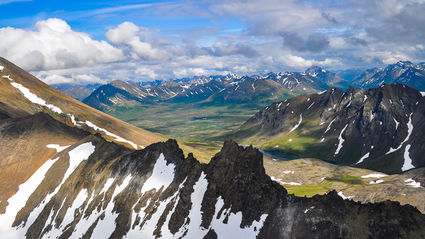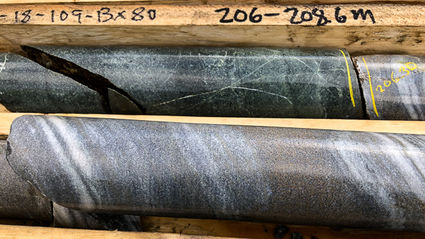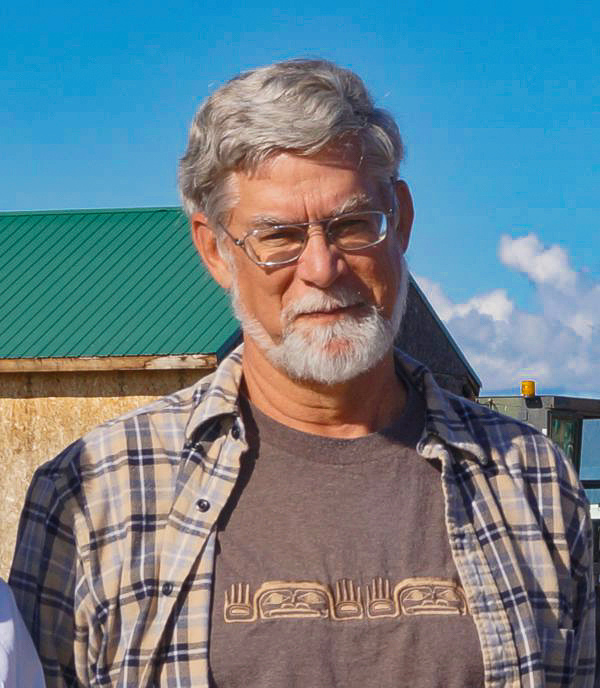Explosion of mining activity in Alaska
Aussie miner buying Pogo, robust PEA for Peak Gold and major miners quietly moving in, activity has profound implications North of 60 Mining News – October 1, 2018
Last updated 9/25/2020 at 6:43am

Riversgold Ltd.
Australia-based Riversgold drilled three targets during its maiden exploration program at its Luna-Quicksilver gold projects in the Kuskokwim Mountains, Southwest Alaska.
Following a couple of quiet months where Alaska's mining industry focused on its work, the last month has seen an explosion of new info come out regarding that effort, some of it profound in its potential immediate, near-term and long-term implications.
For example, one of Alaska's largest mines was sold to a new owner at a surprisingly low cost per ounce. The results of a robust new preliminary economic analysis were tabled by an advanced gold-silver exploration project while another such project announced the commencement of a preliminary economic analysis on its polymetallic project. Several other advanced projects announced encouraging drill results from the Brooks Range, the Alaska Range and Southwestern Alaska. And at least two private companies quietly optioned their base metal projects to two major mining companies, neither of which had been active in Alaska in recent years.
All things considered, a very robust month for Alaska's mineral industry!
WESTERN ALASKA
Riversgold Ltd. announced initial results from its 2018 exploration at its Luna/Quicksilver gold projects in southwestern Alaska. Maiden drilling at the Quicksilver prospect has intersected multiple sulfide veins in the first hole drilled below high-grade gold-bearing similar outcropping veins. Historic work had outlined a 1,000-meter-long zone of rock chip samples assaying over two grams of gold per metric ton within a gold-arsenic-bismuth soil anomaly which follows the northeast-trending structural corridor. More recent work has returned rock samples containing up to 37.6 g/t gold with anomalous silver, arsenic, antimony and bismuth associated with veining and a series of felsic porphyry dikes and sills. Drill hole LQDD003 intersected a medium to coarse grained biotite granite, typical of the North Fork Pluton, intruded by a series of quartz-feldspar porphyry dikes. The hole intersected several arsenopyrite veins, some with colloform banded quartz, similar to those outcropping at surface. Hole LQDD002, drilled at the Luna East prospect, tested below outcropping quartz-sulfide veins within fine-grained sediments. The outcropping veins had previously been sampled and returned up to 3.72 g/t gold with associated silver, arsenic, bismuth and antimony. The hole intersected two quartz feldspar porphyry dikes containing abundant coarse-grained disseminated arsenopyrite and minor pyrrhotite and chalcopyrite. Assays are pending and additional work is in progress.
INTERIOR ALASKA
The big news from Interior Alaska in the last month was Sumitomo Metal Mining Co., Ltd and Sumitomo Corp.'s sale of the Pogo gold mine to Australian newcomer Northern Star Resources Ltd. The $260 million sale price equates to an extremely low $63 per ounce of gold in resource, which currently stands at resources of 3.34 million oz in 8.45 million metric tons grading 12.3 grams of gold per metric ton and reserves of 760,000 oz in 1.99 million metric tons grading 11.9 g/t gold. Since start-up in 2006, the mine has produced 3.8 million oz at an average mine grade of 13.6 g/t gold, including 2017 production of 271,273 ounces at an all-in sustain cost of US$882 per ounce at a head grade average of 10.8 g/t gold. The company indicated that it intends to invest in targeted intensive drilling programs to extend mine life through resource growth and reserve conversion with a focus on completing an updated industry compliant resource estimate by mid-2019. The company will also investigate methods to increase productivities and efficiencies including lower operational costs to strengthen margins and cashflow generation. Welcome to Alaska Northern Star Resources Ltd.
Freegold Ventures Ltd. announced the start of drilling at its Shorty Creek copper-gold project near Livengood. The company has completed approximately 4,500 meters of drilling at Hill 1835, which has largely focused on a 700- by 1,000-meter magnetic anomaly. Porphyry style mineralization is associated with potassic and pervasive sericite alteration, within hornfelsed sedimentary rocks that are cut by porphyritic dykes and sills. The copper mineralization is primarily chalcopyrite with subordinate bornite. Significant results include hole SC 16-01, which averaged 0.36 percent copper, 0.12 grams of gold per metric ton, 7.46 g/t silver and 141 parts per million cobalt over 434.5 meters, including 45 meters grading 0.57 percent copper, 0.38 g/t gold, 9.9 g/t silver and 303 ppm cobalt.
Joint venture partners Contango ORE, Inc. (60 percent) and Royal Gold Inc. (40 percent) announced results of the preliminary economic analysis (PEA) at their Peak gold project near Tok. The study is based on a $1,250 per ounce gold price and $17/oz silver and calls for a two-year construction period followed by an eight-year mine-life designed to produce an average 136,700 oz of gold and 249,500 oz of silver per year at a cash cost of US$428/oz gold and an all-in sustaining cost of US$470/oz gold. The conventional open pit operation and 3,500 metric ton per day carbon-in-leach processing plant will be treating ore at a diluted grade of 3.99 g/t gold and 11.7 g/t silver with recoveries forecast at 91.6 percent for gold and 57 percent for silver. Life of mine strip ratio is 3.9:1. The diesel-powered mine fleet would consist of 64 metric ton capacity haul trucks, seven cubic meter front shovels and seven cubic meter front end loaders. Pre-production capital costs are estimated at US$294 million with US$46 million in life-of-mine sustaining capital costs. The above operation generates a pre-tax net present value of US$393 million at a 5 percent discount rate and an internal rate or return of 37 percent. After-tax, the NPV is $283 million at a 5 percent discount rate with an IRR of 29.1 percent. Resources used in the PEA include measured and indicated resources of 9.2 million metric tons grading 4.08 grams of gold per metric ton, 14.19 g/t silver and 0.153 percent copper; and inferred resources of 1.34 million metric tons grading 2.69 g/t gold, 16.06 g/t silver and 0.151 percent copper. The measured and indicated resources contain 1.21 million oz gold and 4.2 million oz silver; the inferred resource contains 116,400 oz gold and 694,100 oz silver. Copper was assumed to be of zero commercial value and was not included in any of the economic parameters utilized by the PEA. Mining would take place at the oxidized North Peak deposit first followed by the more sulfide-rich Main Peak deposit later in the mine life. High grade, oxidized mineralization exposed at surface in North Peak allows for a 2-year post-construction payback period. The eight-megawatt power requirements of the operation would be supplied from a 100-mile-line connecting to commercial grid-based power at Delta Junction. The PEA also identified a number of areas where project enhancements are likely to exist and provided a series of recommendations designed to improve overall project economics.
ALASKA RANGE
White Rock Minerals Ltd. announced additional drill results from its Red Mountain volcanogenic massive sulfide deposit in the eastern Bonnifield District. Significant results from the previously undrilled Hunter prospect include drill hole HR18-01, which intersected 1.4 meters grading 17.4 percent zinc, 3.9 percent lead, 90 grams of silver per metric ton and 1.6 percent copper from 48.2 meters down-hole; and hole HR18-02, which intersected 1.8 meters grading 13.8 percent zinc, 3.1 percent lead, 56 g/t silver and 0.9 percent copper from 60.8 meters down-hole. These holes tested massive sulfide 50 meters down-dip from the discovery outcrop on the surface and then a second follow-up hole another 30 meters down-dip from that hole and on the same cross section. A third hole tested the mineralized horizon a further 80 meters down dip and intersected five centimeters (two inches) of massive sulfide. The Hunter prospect remains open down dip, and the mineralized horizon that hosts this prospect has been traced for over 500 meters on the surface. Mineralization occurs as east-west striking massive sulfide within a 45 degree north-dipping carbonaceous phyllite that can be traced over 1,000 meters of strike.
PolarX Ltd. announced additional drilling results from the Zackly target on its Alaska Range project. Hole ZX‐18018 intersected multiple mineralized zones including 1.4 meters grading 3.2 percent copper, 9.3 grams of gold per metric ton and 38.2 g/t silver from 285.8 meters down-hole and 2.5 meters grading 2.3 percent copper, 3.5 g/t gold and 18.5 g/t silver from 326.1 meters down-hole. The intercepts are about 100 meters below the nearest hole in the resource base. Hole ZX-18023 intersected 9.3 meters grading 3.3 percent copper, 2.3 g/t gold and 19.7 g/t silver 350 meters east of the current resource base. Copper mineralization occurs as bornite, with lesser amounts of chalcopyrite, covellite, native copper and copper oxides. Mineralization occurs between an altered limestone and an altered basalt. Assays are pending on additional drilling conducted below hole ZX-18023. Other work on the project includes a helicopter-borne magnetic survey at 50-meter line-spacing over the entire northern part of the project, a soil sampling and geological mapping program at 200- by 150-meter grid over the Mars target and detailed mapping and rock-chip sampling at the Moonwalk gold prospect.
Avidian Gold Corp. announce a new gold showing and the staking of an additional 10,880 acres of ground immediately west, south and contiguous with its Golden Zone project. Multiple sulfide-bearing gossan zones at the JJ zone returned gold values up to 6.14 grams of gold per metric ton from vertical dipping gossan zones ranging from 0.5 to more than three meters over a true-width area of approximately 150 meters and a vertical distance of 200 meters. An additional 100 meters of gossan is obscured by talus cover below the outcrops. The strike length of the surface exposure of this new zone is approximately 450 to 500 meters. Sulfide mineralization includes disseminated to semi-massive pyrite with chalcopyrite and arsenopyrite within vertically dipping siltstones and sandstones, intruded by porphyritic dikes. The new staking adjoins the company's Cohio property where limited sampling has returned gold values ranging up to 111 g/t gold. The new discovery at JJ zone is part of a larger 2018 program that includes 3,000 meters of drilling and 46.5 line-kilometers of CSAMT geophysical surveying primarily in the Copper King-Long Creek target area.
New Age Metals Inc. announced the release of its industry compliant technical report on the company's 100 percent owned Genesis nickel-copper-platinum group metal project near Glennallen. Past exploration has revealed the presence of chromite-associated platinum and palladium mineralization and stratabound nickel-copper-platinum mineralization within steeply dipping magmatic layers of the Sheep Hill portion of the Tonsina Ultramafic Complex. The mineralized horizon has been identified in outcrop sampling for 850 meters along strike and a 40 meters true thickness. Platinum group metal values at Genesis are strongly correlated with the chromite rich portions of the mineralized horizon, while nickel and copper are strongly correlated with sulfide rich portions of the mineralized horizon. Metal grades are regular over multiple meter intervals, including six meters grading 804 parts per billion platinum and 1,018 ppb palladium, and 12 meters grading 5,938 parts per million nickel. There has been no drilling on this district-scale project and the strike and depth extent of nickel-copper-platinum mineralization remains untested. Additionally, two areas of banded chromite hosted in dunite and harzburgite on the Bernard Mountain portion of the Tonsina Ultramafic Complex host multiple ppm platinum group metals and a sample of chromite hosted in the olivine websterite unit contains the high values for both platinum and palladium for a combined 5,340 ppb platinum group metal. Outcrop sampling has returned values of 16-9,660 parts ppm nickel, 0.5 to 5,800 ppm copper, 0 to 2,800 ppb platinum, 0 to 2,540 ppb palladium. Limited geochemical sampling and geologic mapping has been conducted over these two mafic-ultramafic massifs. Petrographic and geochemical data suggest the Genesis mineralization is more similar to platinum group metals profiles from layered intrusions such as Stillwater, the Great Dyke, and Penikat, than profiles from ophiolite associated mineralization. Initial work recommended for the project include detailed geologic mapping; grid-based litho-geochemical sampling; 2D and 3D reinterpretation of previously completed airborne and ground geophysical surveys; and acquisition, interpretation and ground-truthing of hyperspectral imagery over the Tonsina ultramafic complex and vicinity.
Nova Minerals Ltd. announce that an 8,000-meter reverse circulation drilling program was under way at its Estelle copper-gold project. This drilling is designed to test along strike north and south of the historic discovery hole SE12-001 at the Oxide prospect, which cut 387 meters grading 0.40 grams of gold per metric ton. Hole SE12-04, drilled to the southeast hole SE12-001, intersected 41.5 meters averaging 1.1 g/t gold, indicating higher gold grades approaching a strong geophysical anomaly further southeast. This geophysical anomaly will be tested in 2018 as the potential center of the intrusion-related gold system. Nova Minerals' 2018 drilling effort is designed to bring the Oxide deposit to a stage where an initial industry-compliant resource estimate can be complete.
NORTHERN ALASKA
Trilogy Metals Inc. and funding partner South32 Ltd. announced initial drilling results from its Bornite deposit at its Upper Kobuk Mineral Projects, a business relationship owned and controlled by Trilogy and NANA Regional Corporation, Inc. Under an option agreement with Trilogy Metals, South32 has the right to form a 50-50 joint venture with respect to Trilogy's Alaskan assets including the Bornite deposit. Through Aug. 19, the company had completed five drill holes comprising a total of 5,267 meters. The objective of the 2018 drilling campaign is to infill and expand the currently defined open pit and underground mineral resources. Mineralization occurs as a series of "reefs" hosted by both the Upper and Lower Bornite Carbonate sequences separated by a generally unmineralized phyllite unit. The copper-cobalt mineralization occurs in three distinct carbonate zones, the Upper Reef, the Lower Reef, and the South Reef. All three zones are being drill tested this year. Initial drilling from the only hole on which assays are available from 2018 exploration includes 16.4 meters grading 5.34 percent copper and 0.21 percent cobalt in hole RC18-0247 in the South Reef trend. The high-grade mineralized zone in RC18-0247 consists of massive chalcopyrite occurring as breccia infill with intergrown pyrite and within dolomite-quartz veins as centimeter scale blebs. Bornite and chalcocite mineralization replace chalcopyrite within the breccia matrix in the highest-grade intervals. The company also indicated that additional funding was contributed to the 2018 effort by South 32, bringing total 2018 budgets to approximately US$10.8 million.
SOUTHEAST ALASKA

Constantine Metal Resources Ltd.
Core from hole CMR18-109, a hole that cut two zones of volcanogenic massive sulfide mineralization that includes a 4.2-meter section that averaged 388 grams per metric ton silver, 3.1 g/t gold, 3.87 percent zinc, 1.09 percent lead and 50.5 percent barite.
Constantine Metal Resources Ltd. and joint venture partner, Dowa Metals & Mining Company Ltd., announced that it has selected JDS Energy & Mining Inc. to prepare a preliminary economic assessment of the potential viability of the mineral resources at the Palmer polymetallic project near Haines. The company has also engaged Klohn Crippen Berger Ltd. to complete the water and waste management design components. An updated mineral resource estimate scheduled for completion in the coming weeks will form the basis of the PEA. While the PEA gets underway, the company continued its 10,000-meter drill program focused on resource expansion and regional targets, including the AG Zone. Inferred mineral resources at the project currently stand at 8.1 million metric tons grading 1.41 percent copper, 5.25 percent zinc, 0.32 grams of gold per metric ton and 31.7 g/t silver.
Ucore Rare Metals Inc. announced that it had entered into an agreement to purchase a comprehensive road and tidewater-accessible land package north of Ketchikan for the development of the company's planned rare earth and strategic metals refinery and separation plant. The company also commenced initial project funding discussions with the Alaska Industrial Development and Export Authority and other lenders to help underwrite capital costs of the facility. Ucore also indicated that it is in the final stages of securing rare earth by-product and primary ore feedstock for the facility.




















Reader Comments(0)